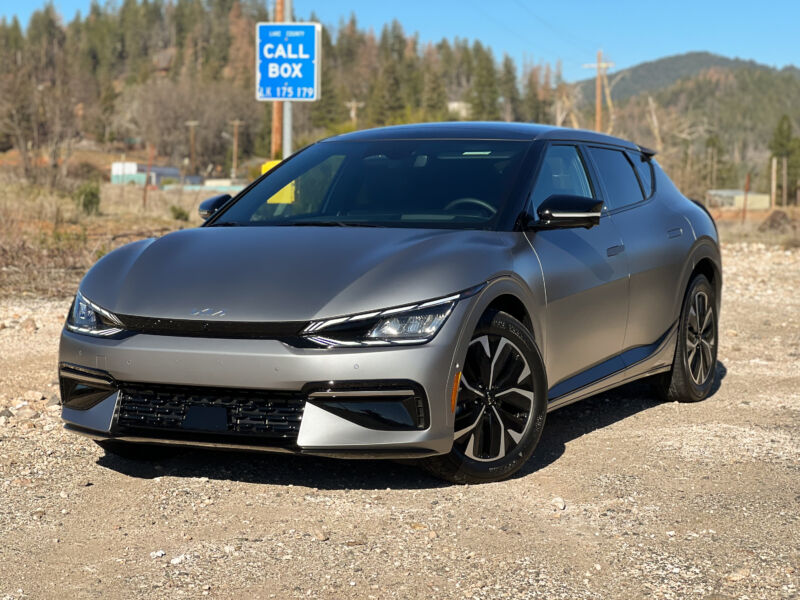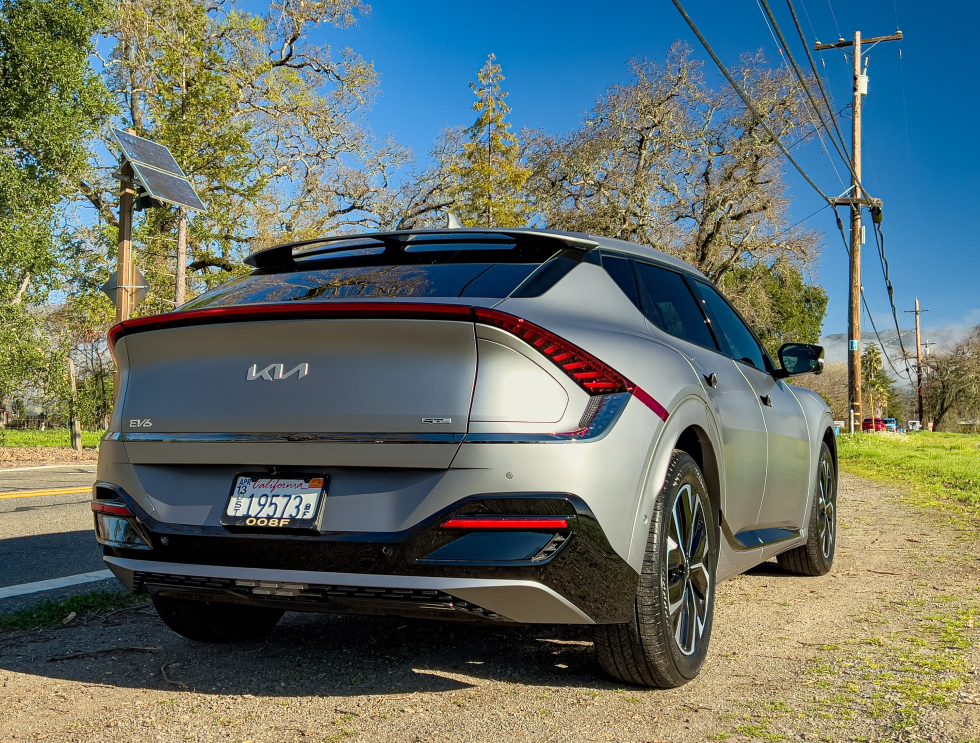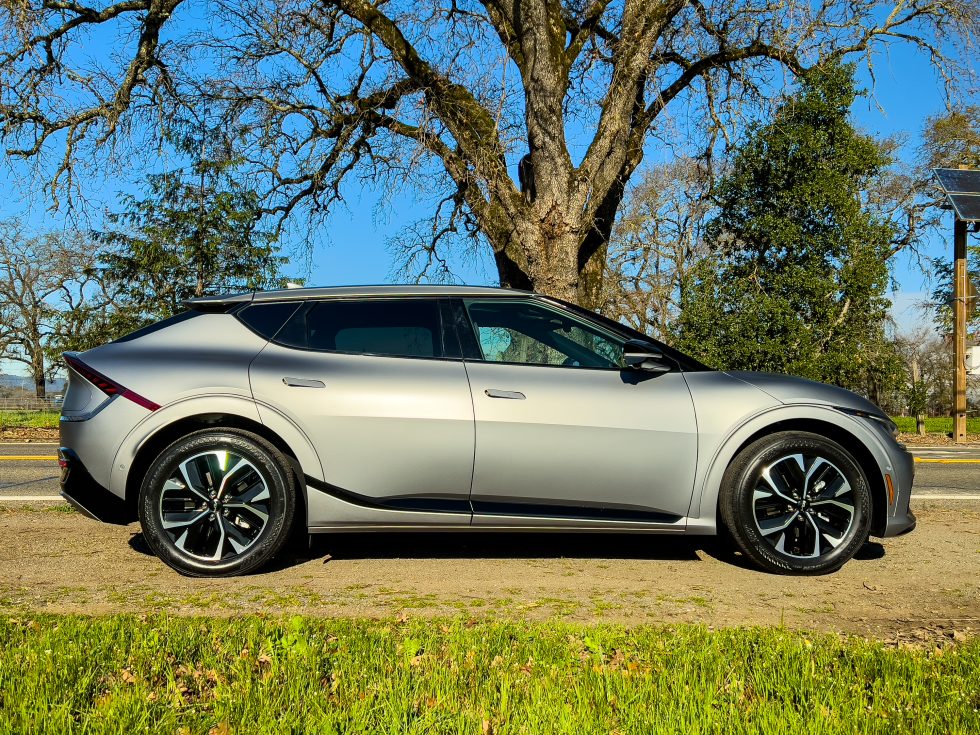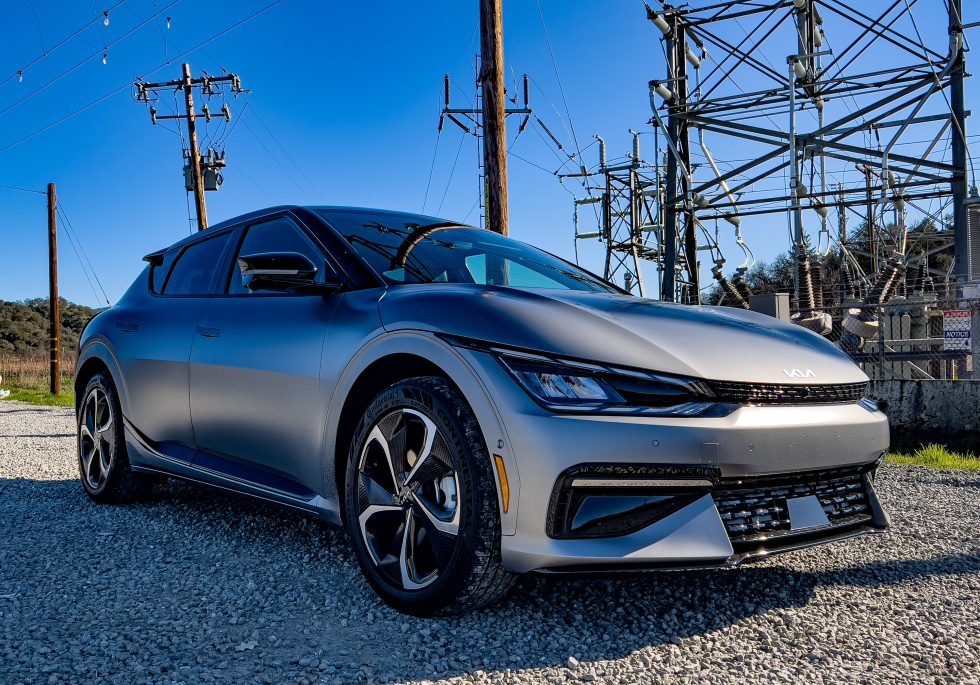
Jonathan Gitlin
HEALDSBURG, Calif.—Remember how, a few decades ago, the Japanese car industry came and ate everyone’s lunch? History doesn’t repeat, the aphorism goes, but it does rhyme. And this time around, the lunch-eating is courtesy of Korea’s automakers.
That’s especially true with electric vehicles. The second-generation EVs from Kia and parent company Hyundai were some of the few to get close to Tesla-levels of powertrain efficiency. The companies applied that knowledge to create E-GMP, a purpose-built 800 V platform for larger rear- and all-wheel-drive EVs.
The first vehicle to get that powertrain was the Hyundai Ioniq 5, which went straight to the top of the class when we tested it in late 2021. Today, we drive the Ioniq 5’s cousin, the Kia EV6. If the Ioniq 5 is all pixels and angles, the EV6 starts with a similar bone structure but drapes it in a much curvier crossover body. Everyone’s tastes differ, so I try not to dwell on a car’s looks, but from some angles the EV6 is a better-looking Lamborghini Urus. And its rear styling definitely reminds me of the Aston Martin DBX.

Jonathan Gitlin
Karim Habib, Kia’s head of design, humored the suggestion. He conceded that, from the rear and if you squinted, “there are some similarities. But no. For us what was important was to use the potential of the architecture,” he said. “What EV platforms really allow us is definitely more freedom, and also, I think, just in general, there’s an openness for body types that are maybe not clearly placed in one segment or another. We just wanted to try something like that.”
The associated journalists at the first drive in California had different opinions about which form factor best describes the EV6. The Kia staffers on hand, however, were resolute in calling the EV6 a CUV.
“Having this flat floor allows you to sit in a more flexible way,” Habib explained. “You don’t have a particularly fixed space for your feet or your heels. You can twist, you can slide. Yes, the disadvantage is it does build more height, but there are some things that, in return, help us.” He pointed to the trend for ever-bigger wheels that make a big car read as a smaller one until you get up close.
“So the wheel-to-body relationship stays quite healthy,” he told me. “What becomes a bit more tricky is that, when you go shorter, you stay high. That’s why you see so many EVs in the crossover or SUV direction, because it just works.”

Jonathan Gitlin
E-GMP was always meant for larger vehicles (Kia has cheaper front-wheel-drive EVs like the Niro for the actual small-car market). And so the EV6 is bigger than you first think. At 184.3 inches (4,681 mm), the EV6 is a couple of inches longer than the Ioniq 5, but its 114.2 inches (2,901 mm) wheelbase is slightly shorter than its predecessor. (Yes, that’s also the same wheelbase as Kia’s much larger Telluride three-row SUV.)
Three powertrains to choose from
The EV6’s powertrain layout is conventional for a battery EV, with a slab of lithium-ion polymer cells between the axles. The entry-level model is the $40,900 (before tax credits) rear-wheel-drive EV6 Light. The Light’s 58 kWh battery pack powers a 167 hp (125 kW), 258 lb-ft (350 Nm) AC synchronous permanent-magnet motor which, in turn, drives the rear wheels. Curb weight for this version is 4,017 lbs (1,822 kg), of which 816 lbs (370 kg) are from the battery pack.
The Light has a range of 232 miles (373 km). The E-GMP platform can fast charge to 80 percent in 18 minutes when connected to a 350 kW charger or 63 minutes if you can only find a 50 kW DC charger. (Technically, the smaller pack won’t charge at more than 180 kW but you’ll need to find a 350 kW-capable charger to see those speeds.) Level 2 AC charging will take just under six hours at 11 kW.

Jonathan Gitlin
Kia didn’t have any EV6 Lights for us to sample, but we did spend a good amount of time behind the wheel of the other two powertrain variants. Both use a 77.4 kWh (gross capacity) battery pack. The single-motor RWD configuration sports 225 hp (168 kW) and 258 lb-ft (350 Nm) to achieve 310 miles (499 km) of range. The twin-motor all-wheel-drive arrangement is 320 hp (239 kW) and 446 lb-ft (605 Nm) for a range of 274 miles (441 km).
As with the less-powerful EV6, these are AC permanent-magnet synchronous motors. The motors can rev to 15,000 rpm (versus 11,000 rpm in the Niro) and use square copper hairpins and oil cooling. The front motor, if fitted, is connected to a disconnect device so it can be rapidly uncoupled from the wheels to prevent drag. To maximize energy recovery through regenerative braking, however, the motor always recouples when you decelerate.
Both motor configurations are available in either Wind trim ($47,000 for RWD or $50,900 for AWD) or the slightly lighter but sportier-looking GT-Line ($51,200 for RWD, $55,900 for AWD). (All these prices are before tax credits, by the way). These EV6s weigh a bit more—the larger pack weighs 1,052 lbs (477 kg), so curb weights range from 4,225-4,661 lbs (1,916-2,114 kg).
Charging times for the larger pack are the same, regardless of whether it’s a single- or dual-motor version. A 350 kW charger (actual max power: 240 kW) will get you to 80 percent in 18 minutes, while a 150 kW-rated fast charger does the job in 25 minutes. (Unlike many other EVs, the EV6’s platform allows it to fast charge at either 800 V or 400 V. How? The motor and inverter act as a DC-DC converter.) For everyday charging at home or work, expect a full charge in just over seven hours with an 11 kW (48 A) AC source.
